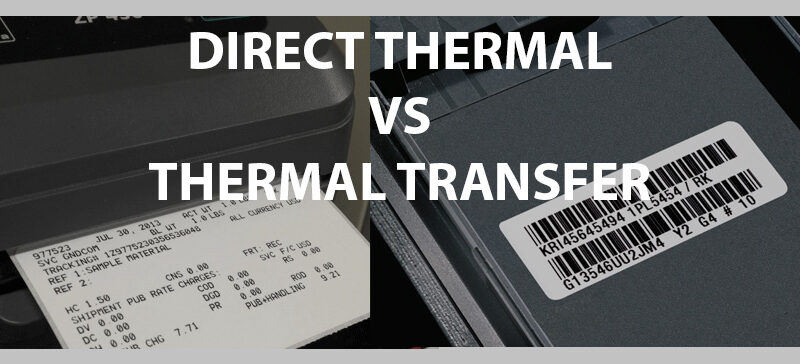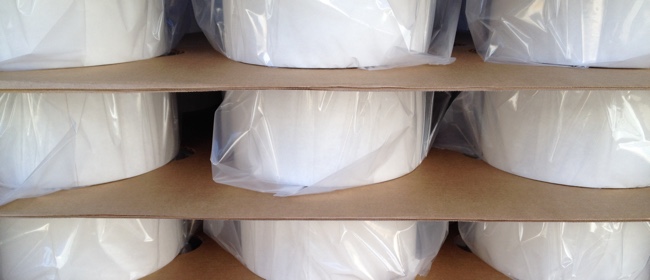If you need to print labels in-house, you might be wondering what the differences are between direct thermal vs thermal transfer labels. Both direct thermal and thermal transfer printers use a thermal printhead that applies heat to special label stock. In each case, you’ll get a high-quality image that can be printed within tight tolerances. However, each type of printing is best suited for different circumstances.
When deciding between direct thermal vs thermal transfer labels, you’ll need to consider how long the label needs to last as well as the conditions they’ll be subjected to. Read on to learn more about direct thermal vs thermal transfer printing and which labels are best suited for your needs.
Learn About Thermal Transfer Labels
What is Direct Thermal Printing?
Direct thermal printing is pretty much exactly what it sounds like. Using specially treated label stock, the thermal printhead applies heat. The label stock blackens when heated, causing your text, barcode, or image to be printed. With direct thermal printing, there is no ink, no toner, and no ribbon. Most mobile printing devices use direct thermal printing due to its simplicity.
Pros & Cons of Direct Thermal Printing
There’s a lot to love about direct thermal printing. Direct thermal printers have fewer components, which means fewer component parts that need to be maintained. And with no ribbons, toners, or ink cartridges to buy, supply costs are lower than other kinds of printers. Direct thermal printers print crisp images and sharp lines, making them an excellent option for printing barcodes and QR codes. Additionally, direct thermal printers can print high volumes in a short amount of time.
However, there are a few drawbacks to direct thermal printing. The label stock used with direct thermal labels is heat sensitive, which means sun and heat exposure will affect the legibility. Direct thermal labels can also be marred by abrasion. In general, direct thermal labels are better suited for your short-term needs–labels that will be used for six months or less.
Uses of Direct Thermal Labels
Direct thermal labels are used in a variety of industries because of the quality of printing, as well as the ease of use. Some of the most popular uses of direct thermal labels include:
- Shipping labels: Direct thermal labels are widely used for shipping. Labels can be printed quickly and only need to last through the shipping process.
- Food labels: Because direct thermal labels use no ink, they are an excellent choice for labeling foods.
- Name tags: When you need name tags for a conference or other event, direct thermal printing is a great option. Direct thermal printers print high volumes quickly and inexpensively.
Learn About Direct Thermal Labels
What is Thermal Transfer Printing?
When comparing direct thermal vs thermal transfer, it’s important to note that the printing processes are slightly different. Just like a direct thermal printer, a thermal transfer printer uses a thermal printhead to heat the label stock and print the text or image. The big difference between the two is that thermal transfer printers print with a ribbon that melts dyed wax or resin into the label when heat is applied. Because the text or image is absorbed into the label stock, thermal transfer labels last longer and can endure heat and UV light.
Pros & Cons of Thermal Transfer Printing
One of the biggest advantages of thermal transfer printing is the longevity of the labels. If you need your label to last for more than six months, thermal transfer printing is the way to go. In addition to withstanding heat and UV light, thermal transfer labels are also chemical resistant. Thermal transfer printers work with a variety of label stock, including paper, plastic, and polyester. And unlike direct thermal printers, thermal transfer printers can use a colored ribbon to print colored text and images.
Thermal transfer printing does come with some cons, though. One of the major disadvantages of thermal transfer printing is the cost. Because there are more component parts, thermal transfer printers require more maintenance to keep them working. Plus, the ribbon needs to be changed regularly, so supply costs can add up.
Thermal Transfer Label Uses
Because of their durability, thermal transfer labels are used for long-term labeling as well as in extreme conditions. Here are some of the most common uses of thermal transfer labels:
- Asset tracking: Thermal transfer asset labels last for a long time to help you easily track your assets to prevent theft and loss.
- Laboratory specimens: Thermal transfer labels can hold up to the extreme conditions of the lab, including chemicals and heat.
- Outdoor use: Thermal transfer labels won’t fade or become obscured when exposed to UV light or heat, making them ideal for outdoor use.
Direct Thermal vs Thermal Transfer Labels
Now that you know the difference between direct thermal vs thermal transfer printing, you know that the best thermal label will depend on your needs. If you need to print high volumes of labels that will be used for six months or less, direct thermal labels are an excellent choice. However, if you’re looking for a label with more durability, thermal transfer labels will be better suited for your needs.
Looking for custom direct thermal or thermal transfer labels? Coast Label has you covered. We’ll help you choose the right label stock and adhesive for your unique application. Contact Coast Label today to get your free proposal!



